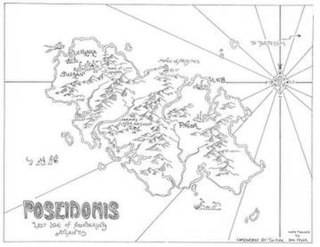
Poseidonis is the fictional last remnant of the lost continent of Atlantis, mentioned by Algernon Blackwood in his short story, "Sand", in his story collection, Four Weird Tales and is also detailed in a series of short stories by Clark Ashton Smith. Smith based Poseidonis on Theosophical scriptures about Atlantis, and his concept of "the last isle of foundering Atlantis" is echoed by the Isle of Númenor in J. R. R. Tolkien's legendarium.
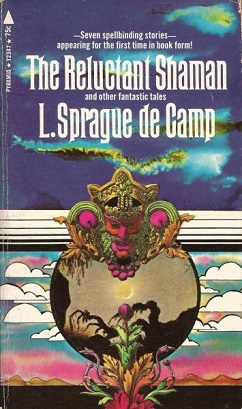
The Reluctant Shaman and Other Fantastic Tales is a collection of short stories by American science fiction and fantasy author L. Sprague de Camp, first published in paperback by Pyramid Books in November 1970. An E-book edition was published by Gollancz's SF Gateway imprint on September 29, 2011 as part of a general release of de Camp's works in electronic form. The pieces were originally published between 1939 and 1958 in the magazines Thrilling Wonder Stories, Unknown, and Fantastic Universe. The collection has also been translated into French and German.

The Tritonian Ring and Other Pusadian Tales is a 1953 collection of stories by American science fiction and fantasy author L. Sprague de Camp, first published in hardcover by Twayne Publishers. An E-book edition was published as The Tritonian Ring and Other Pasudian [sic] Tales by Gollancz's SF Gateway imprint on September 29, 2011 as part of a general release of de Camp's works in electronic form. The pieces were originally published between 1951 and 1953 in the magazines and anthologies Two Complete Science Adventure Books, Fantasy Fiction, Imagination Stories of Science and Fantasy, and Fantastic Adventures. The title story, the novel The Tritonian Ring has also been published separately.

Conan the Avenger is a 1968 collection of two fantasy works written by Björn Nyberg, Robert E. Howard and L. Sprague de Camp featuring Robert E. Howard's sword and sorcery hero Conan the Barbarian. It was first published in paperback by Lancer Books, and has been reprinted a number of times since by various publishers. It has also been translated into Japanese, German and Spanish.

Conan the Warrior is a 1967 collection of three fantasy short stories by American writer Robert E. Howard, featuring his sword and sorcery hero Conan the Barbarian. The collection is introduced and edited by L. Sprague de Camp. The stories originally appeared in the fantasy magazine Weird Tales in the 1930s. The book has been reprinted a number of times since by various publishers, and has also been translated into Japanese, German, French, Polish, Spanish, Swedish and Italian.
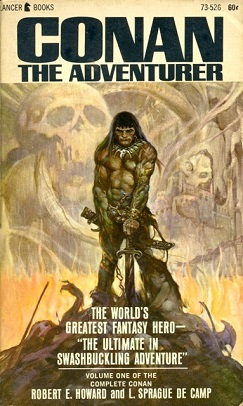
Conan the Adventurer is a 1966 collection of four fantasy short stories by American writers Robert E. Howard and L. Sprague de Camp, featuring Howard's sword and sorcery hero Conan the Barbarian. Most of the stories originally appeared in the fantasy magazine Weird Tales in the 1930s. The book has been reprinted a number of times since by various publishers, and has also been translated into German, French, Japanese, Spanish, Italian, Swedish and Dutch. It was later gathered together with Conan the Wanderer and Conan the Buccaneer into the omnibus collection The Conan Chronicles 2 (1990).

Conan the Usurper is a 1967 collection of four fantasy short stories by American writer Robert E. Howard and L. Sprague de Camp, featuring Howard's sword and sorcery hero Conan the Barbarian. Most of the stories originally appeared in the fantasy magazine Weird Tales in the 1930s. The book has been reprinted a number of times since by various publishers, and has also been translated into German, Spanish, Italian, Swedish and Dutch.
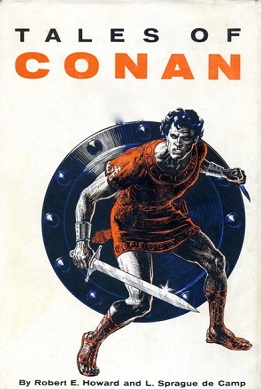
Tales of Conan is a 1955 collection of four fantasy short stories by American writers Robert E. Howard and L. Sprague de Camp, featuring Howard's sword and sorcery hero Conan the Barbarian. The tales as originally written by Howard were adventure yarns mostly set in the Middle Ages; they were rewritten as Conan stories by de Camp, who also added the fantastic element. Three of the stories also appeared in the fantasy magazine Fantastic Universe, two of them before publication of the collection and the other one after. The book has also been translated into Japanese. The collection never saw publication in paperback; instead, its component stories were split up and distributed among other "Conan" collections. "The Flame Knife" was later also published as an independent paperback.

The Conan Reader is a 1968 essay collection by L. Sprague de Camp, published in hardcover by Mirage Press. The essays were originally published as articles in George H. Scithers' fanzine Amra. Mirage subsequently published two companion volumes of essays from The Conan Swordbook (1969) and The Conan Grimoire (1972). Most of the material in the three volumes, together with some additional material, was later reprinted in two de Camp-edited paperback anthologies from Ace Books; The Blade of Conan (1979) and The Spell of Conan (1980).

The Tritonian Ring is a heroic fantasy novel written by L. Sprague de Camp as part of his Pusadian series. It was first published in the magazine Two Complete Science Adventure Books for Winter, 1951, and first appeared in book form in de Camp's collection The Tritonian Ring and Other Pusadian Tales. Its first publication as a stand-alone novel was as a paperback by Paperback Library in 1968; the first hardcover edition was from Owlswick Press in 1977. An E-book edition was published as The Tritonian Ring and Other Pasudian [sic] Tales by Gollancz's SF Gateway imprint on September 29, 2011 as part of a general release of de Camp's works in electronic form.

"The Owl and the Ape" is a fantasy story by American writer L. Sprague de Camp, part of his Pusadian series. It was first published in the magazine Imagination: Stories of Science and Fantasy for November, 1951, and first appeared in book form in the de Camp's collection The Tritonian Ring and Other Pusadian Tales. The story has also appeared in the anthology Kingdoms of Sorcery (1976). and the de Camp omnibus collection Lest Darkness Fall/Rogue Queen/The Tritonian Ring and Other Pusadian Tales (2014). It has also been translated into German.
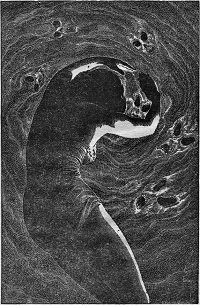
"The Eye of Tandyla" is a fantasy story by American writer L. Sprague de Camp, part of his Pusadian series. It was first published in the magazine Fantastic Adventures for May, 1951, and first appeared in book form in de Camp's collection The Tritonian Ring and Other Pusadian Tales. The story has also appeared in the magazine Fantastic for November 1965, the anthologies Time Untamed (1967), The Magic of Atlantis (1970), Wizards (1983), and The Mammoth Book of Seriously Comic Fantasy (1999), and the de Camp omnibus collection Lest Darkness Fall/Rogue Queen/The Tritonian Ring and Other Pusadian Tales (2014). It has also been translated into French, Spanish, Italian, German and Russian.

"The Hungry Hercynian" is a fantasy short story by American writer L. Sprague de Camp, part of his Pusadian series. It was first published in the magazine Universe Science Fiction for December, 1953, and first appeared in book form in the anthology The Spell of Seven, edited by de Camp. It has also been translated into German, and was first brought together with other works of de Camp in the German collection Die Chronik von Poseidonis.
"The Stone of the Witch-Queen" is a fantasy short story by American writer L. Sprague de Camp, part of his Pusadian series. It was first published in the magazine Weirdbook for fall 1977. It has also been translated into Dutch and German. Chronologically, "The Stone of the Witch Queen" is the fifth of de Camp's Pusadian tales, and the third to feature his protagonist Gezun of Lorsk.

"Ka the Appalling" is a fantasy story by American writer L. Sprague de Camp, part of his Pusadian series. It was first published in the magazine Fantastic Universe for August, 1958, and first appeared in book form in the anthology The Young Magicians, edited by Lin Carter. It was first brought together with other works of de Camp in his collection The Reluctant Shaman and Other Fantastic Tales. It has also been translated into French, German, and Italian.
"The Rug and the Bull" is a fantasy short story by American writer L. Sprague de Camp, part of his Pusadian series. It was first published in the anthology Flashing Swords! #2, edited by Lin Carter. It has also been translated into Italian, German and Dutch.

"The Stronger Spell" is a fantasy short story by American writer L. Sprague de Camp, part of his Pusadian series. It was first published in the magazine Fantasy Fiction for November 1953, and first appeared in book form in de Camp's collection The Tritonian Ring and Other Pusadian Tales. It has since been reprinted in the anthology The Mighty Barbarians, edited by Hans Stefan Santesson. It was included in the omnibus de Camp collection Lest Darkness Fall/Rogue Queen/The Tritonian Ring and Other Pusadian Tales published in trade paperback by Gollancz in February 2014 and as an ebook by Gateway/Orion in March of the same year. It has also been translated into Dutch and German.
Bibliography of science fiction, fantasy, historical fiction and nonfiction writer L. Sprague de Camp:

"The Galton Whistle" is a science fiction short story by American writer L. Sprague de Camp, a story in his Viagens Interplanetarias series. It is the first (chronologically) set on the planet Vishnu. It was first published, as "Ultrasonic God," in the magazine Future Combined with Science Fiction Stories in the issue for July, 1951. It first appeared in book form under the present title in the collection The Continent Makers and Other Tales of the Viagens, published in hardcover by Twayne Publishers in 1953, and in paperback by Signet Books in 1971. It also appeared in the anthologies Novelets of Science Fiction, The Good Old Stuff, and The Good Stuff. The story has been translated into Portuguese, Dutch, and Italian.

"Summer Wear" is a science fiction short story by American writer L. Sprague de Camp, part of his Viagens Interplanetarias series. It is the first (chronologically) set on the planet Osiris. It was first published in the magazine Startling Stories in the issue for May, 1950. It first appeared in book form in the anthology The Best Science Fiction Stories: 1951, edited by Everett F. Bleiler and T. E. Dikty, published in hardcover by Frederick Fell in 1951, and was gathered together with other Viagens stories in the collection The Continent Makers and Other Tales of the Viagens, published in hardcover by Twayne Publishers in 1953, and in paperback by Signet Books in 1971. The story has been translated into Portuguese, Dutch, Italian and German.


















